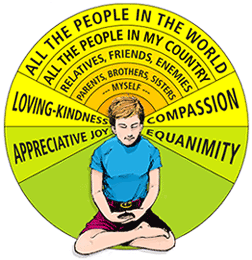
Everyone wants to be happy, but happiness cannot be achieved in isolation. The happiness of one depends upon the happiness of all and the happiness of all depends upon the happiness of one. This is because all life is interdependent. In order to be happy, one needs to cultivate wholesome attitudes towards others in society and towards all sentient beings.
 The best way of cultivating wholesome attitudes towards all sentient beings is through meditation. Among the many topics of meditation taught by the Buddha, there are four specifically concerned with the cultivation of loving-kindness, compassion, appreciative joy and equanimity. These four are called the Four Immeasurables because they are directed to an immeasurable number of sentient beings, and because the wholesome karma produced through practising them is immeasurable. The four are also called the sublime states of mind because they are like the extraordinary states of mind of the gods.
The best way of cultivating wholesome attitudes towards all sentient beings is through meditation. Among the many topics of meditation taught by the Buddha, there are four specifically concerned with the cultivation of loving-kindness, compassion, appreciative joy and equanimity. These four are called the Four Immeasurables because they are directed to an immeasurable number of sentient beings, and because the wholesome karma produced through practising them is immeasurable. The four are also called the sublime states of mind because they are like the extraordinary states of mind of the gods.






